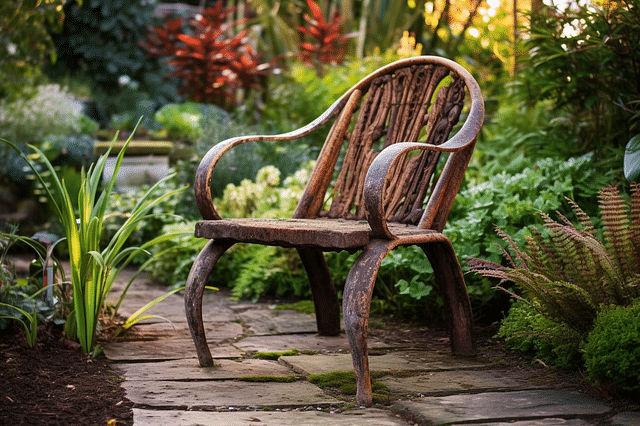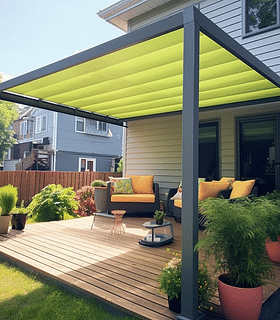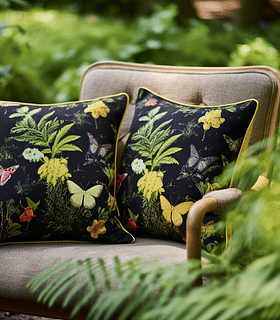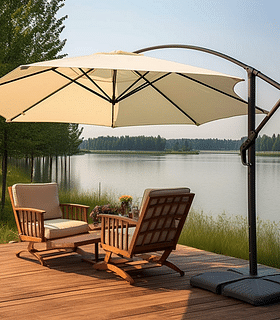Fixing Rusty Patio Chair Legs: A Step-by-Step Guide
Revive your outdoor seating with our comprehensive step-by-step guide on fixing rusty patio chair legs. Discover how to assess the damage, remove rust, and protect against future corrosion. Rejuvenate your outdoor space today.

Have you ever gone to sit down on your patio chair, only to find that the legs are rusted and unstable? It can be frustrating and even dangerous to have wobbly chair legs that threaten to give way at any moment. But don't worry, we've got you covered! In this step-by-step guide, we will walk you through the process of fixing rusty patio chair legs, so you can enjoy a sturdy and comfortable seating experience once again. From assessing the damage to applying the right treatment, we will cover it all. So grab your tools and let's dive in!
Assessing the Damage
Before you can begin the process of restoring your patio chair legs, it's essential to assess the damage to determine the extent of rust and corrosion. By understanding the condition of the chair legs, you'll be better equipped to plan your restoration approach. In this section, we'll cover how to determine the extent of rust damage on patio chair legs, signs of corrosion to look for on rusty patio chair legs, and the tools and techniques you can use to assess the condition of the chair legs.
How to Determine the Extent of Rust Damage on Patio Chair Legs
To determine the extent of rust damage on your patio chair legs, you'll need to closely examine the affected areas. Here are a few steps to guide you:
Inspect the surface: Carefully examine the legs, looking for signs of rust and degradation. Pay particular attention to any areas that appear discolored, pitted, or flaking.
Check for structural integrity: Gently inspect the legs for any signs of weakness or damage. Look for areas where the metal may have become thin or weakened from rust.
Assess the level of rust: Determine how deeply the rust has penetrated the metal surface. Light surface rust may only require cleaning and minor touch-ups, while deep rust may necessitate more extensive restoration.
Consider the overall condition: Take into account the condition of the rest of the chair, as well as the importance of preserving its original features. This will help you decide on the appropriate level of restoration needed.
By carefully examining the extent of rust damage on your patio chair legs, you'll have a clearer understanding of the steps required to restore them to their former glory.
Signs of Corrosion to Look for on Rusty Patio Chair Legs
When inspecting rusty patio chair legs, there are several signs of corrosion you should be on the lookout for. These signs can help you assess the severity of the damage and determine the best course of action. Here are a few common signs to watch out for:
Surface discoloration: Rust often manifests as a reddish-brown discoloration on the metal surface. Look for areas that appear darker than the surrounding metal or have an uneven coloration.
Pitting and texture changes: Corrosion can cause the metal surface to become pitted, with small holes or rough patches. Run your hand along the surface to feel for any irregularities in texture.
Flaking or peeling paint: As rust develops, it can cause the paint to bubble, flake, or peel off the surface. Check for any areas where the paint has deteriorated, as this may indicate underlying rust.
Weakness or instability: Excessive rust can weaken the structure of the chair legs. Test the stability of the legs by gently applying pressure or wiggling them. Look out for any noticeable movement or instability.
By recognizing these signs of corrosion, you'll be better able to assess the severity of the damage and determine the necessary steps for restoration.
Tools and Techniques for Assessing the Condition of the Chair Legs
To accurately assess the condition of your patio chair legs, there are several tools and techniques you can use. These tools will help you gain a better understanding of the current state of the legs and guide your restoration process. Here are a few key tools and techniques:
Magnifying glass: Use a magnifying glass to get a closer look at the rusted areas. This will help you identify any small details or patterns that may not be visible to the naked eye.
Rust converter solution: Apply a rust converter solution to the affected areas to neutralize the rust and prevent further spread. This will help you determine the true extent of the rust damage once the converter has done its job.
Rubber mallet: Gently tap the legs with a rubber mallet to test the structural integrity. This will help you identify any weakened areas or potential points of concern.
Metal brush or wire wool: Use a metal brush or wire wool to remove surface rust and corrosion. This will allow you to evaluate the underlying condition of the metal and determine the necessary restoration steps.
By utilizing these tools and techniques, you'll be able to assess the condition of your patio chair legs more accurately. This assessment will provide you with valuable insights to guide your restoration process and ensure the best possible outcome.
Removing Rust from Patio Chair Legs
Rust can be a common issue for outdoor furniture, especially patio chair legs. Over time, exposure to moisture and elements can cause rust to develop, leaving your once beautiful chairs looking worn and neglected. But fear not, because removing rust from patio chair legs is easier than you might think. In this section, we'll walk you through a step-by-step process for removing rust, recommend some effective rust removal products and tools, and discuss the safety precautions you should take when working with rust removal chemicals.
Step-by-step process for removing rust from patio chair legs
Start by inspecting the extent of the rust on your patio chair legs. If the rust is minor and superficial, you may be able to remove it with simple household items like baking soda or vinegar. However, if the rust is more severe, you may need to use a dedicated rust remover.
If using baking soda or vinegar, create a paste by mixing them with water. Apply the paste to the rusted areas of the chair legs and let it sit for at least 30 minutes. Then, scrub the rusted areas with a soft-bristle brush or sponge until the rust is loosened. Rinse off the paste with water and dry the chair legs thoroughly.
If the rust persists, you can try using a commercial rust remover. There are various rust removal products available in the market, such as rust converter sprays or rust dissolving gels. Follow the instructions provided by the manufacturer to apply the product effectively. Typically, you'll need to brush or spray the rust remover onto the affected areas, let it sit for a specified period, and then scrub off the loosened rust with a brush. Rinse the chair legs with water and dry them completely.
Once you have successfully removed the rust, it's important to protect the chair legs from future rusting. You can apply a coat of rust-inhibiting primer or paint to provide a barrier against moisture and prevent further rust formation.
Recommended rust removal products and tools
- Baking soda: This common kitchen ingredient can be an effective rust remover, especially for minor rust stains. It's non-toxic and safe to use.
- Vinegar: Another household item, vinegar's acidic nature helps dissolve rust. You can mix it with baking soda to create a DIY rust removal paste.
- Rust converter sprays: These sprays chemically convert rust into a stable compound that prevents further corrosion. They are easy to use and effective for moderate rust removal.
- Rust dissolving gels: Gels are ideal for vertical surfaces or intricate designs on chair legs. They cling to the rusted areas and work to dissolve the rust over time.
- Soft-bristle brush or sponge: Use a soft brush or sponge to gently scrub off the rust without damaging the chair legs.
Safety precautions to take when working with rust removal chemicals
- Always read the instructions and warnings provided by the manufacturer before using any rust removal products.
- Work in a well-ventilated area to avoid inhaling fumes or vapors from rust removal chemicals.
- Wear protective gloves and safety goggles to protect your skin and eyes from potential contact with chemicals.
- If working with strong chemical rust removers, consider wearing a mask to protect yourself from breathing in potentially harmful fumes.
- Keep children and pets away from the area where you're working with rust removal chemicals.
- After completing the rust removal process, properly dispose of any chemical residue or packaging according to local regulations.
By following these steps and taking necessary safety precautions, you can successfully remove rust from your patio chair legs and restore their original beauty. Don't let rust get in the way of enjoying your outdoor space!
Protecting Against Future Corrosion
As much as we try to prevent it, corrosion can still occur on our patio furniture over time. However, there are several steps you can take to protect against future corrosion and keep your furniture looking great for years to come.
How to prevent further rust formation on patio chair legs
Rust formation on the legs of your patio chairs can not only be unsightly, but it can also weaken the structure of the furniture. To prevent further rust formation on your patio chair legs, follow these simple steps:
Regularly clean your patio furniture: Dirt, dust, and debris can trap moisture, leading to rust formation. Make it a habit to clean your patio furniture regularly to remove any buildup. Use a gentle soap or detergent and a soft brush or cloth to clean the legs thoroughly.
Apply a rust-inhibiting spray: After cleaning your patio chair legs, consider applying a rust-inhibiting spray. These sprays form a protective barrier that helps prevent rust from forming. Simply spray the legs evenly and let them dry completely before using the furniture.
Use furniture covers or storage during harsh weather: Patio furniture is exposed to the elements, which can accelerate corrosion. During periods of heavy rain, snow, or extreme heat, it's a good idea to cover your furniture with waterproof covers or store them in a protected area. This will help to prevent moisture from reaching the metal surfaces and minimize the risk of corrosion.
Applying protective coatings and finishes to deter corrosion
Another effective way to protect your patio furniture from corrosion is by applying protective coatings and finishes. Here are a few options to consider:
Powder coating: Powder coating is a durable and long-lasting protective finish that can be applied to metal surfaces. It creates a thick, even layer that acts as a barrier against moisture and prevents corrosion. Consider having your patio furniture professionally powder coated for the best results.
Paint with rust-inhibiting properties: If your furniture is not already powder coated, you can still add a layer of protection by painting it with a high-quality paint that has rust-inhibiting properties. Make sure to clean and prepare the surface before painting to ensure proper adhesion.
Clear sealants: Clear sealants can be applied to metal surfaces to provide a protective barrier against moisture and corrosion. These sealants are easy to apply and can be found in most home improvement stores. Follow the manufacturer's instructions for the best application method.
Best practices for maintaining the longevity of your patio furniture
In addition to rust prevention techniques, there are a few best practices you can follow to maintain the longevity of your patio furniture:
Regularly inspect your furniture for any signs of damage or wear. Address any issues promptly to prevent further damage.
Avoid placing hot objects directly on metal surfaces, as this can cause discoloration and damage the protective coatings.
Keep your furniture covered or stored during the off-season or when not in use for extended periods of time. This will help protect it from harsh weather conditions and reduce the risk of corrosion.
By following these simple steps and incorporating these best practices, you can effectively protect your patio furniture against future corrosion and ensure its longevity. Your furniture will not only look great but also provide a comfortable and enjoyable outdoor space for years to come.
Rejuvenating Your Outdoor Space
Everyone loves spending time in their outdoor space, whether it's a small balcony or a sprawling backyard. But over time, the elements can take a toll on outdoor furniture and decor, leaving them looking dull and worn. If your outdoor space is in need of a makeover, don't worry! We have some simple and effective tips to help you rejuvenate your outdoor oasis.
Clean and restore the overall appearance of patio chair legs
One of the most noticeable elements of your outdoor seating is the legs of your patio chairs. Over time, these legs can accumulate dirt, grime, and even rust, making them look unsightly. But fear not, because cleaning and restoring the appearance of your patio chair legs is easier than you might think.
Start by giving your chair legs a good scrub with a mild detergent and warm water. Use a soft brush or sponge to gently scrub away dirt and stains. If you come across stubborn rust spots, gently sand them away with fine-grit sandpaper. Once clean, rinse the chair legs thoroughly and allow them to dry completely before applying any paint or finish.
To restore the appearance of your chair legs, consider giving them a fresh coat of paint or stain. Choose a color that complements your outdoor decor and apply it evenly using a brush or spray paint. For added protection, finish off with a clear sealant to ensure the longevity of your newly rejuvenated chair legs. With this simple cleaning and restoring process, your patio chairs will look as good as new!
Strategies for enhancing the aesthetic appeal of your outdoor seating
When it comes to the overall look of your outdoor seating, there are several strategies you can employ to enhance its aesthetic appeal. Follow these tips to revitalize your outdoor space and create a welcoming atmosphere for you and your guests:
Replace worn-out cushions: Over time, outdoor cushions can fade, flatten, or get damaged. Consider replacing them with new cushions in vibrant colors or patterns to instantly breathe new life into your outdoor seating.
Add throw pillows: Don't be afraid to accessorize your outdoor seating with throw pillows. Choose pillows that complement the colors of your outdoor furniture and add a pop of personality to your space.
Incorporate outdoor rugs: Outdoor rugs not only add warmth and comfort to your seating area but also anchor the space and tie everything together. Choose a rug that is designed to withstand outdoor conditions and is easy to clean.
Create a focal point: Whether it's a statement piece of furniture, an eye-catching sculpture, or a stunning plant arrangement, creating a focal point in your outdoor seating area adds visual interest and draws attention to the space.
Additional tips and tricks to revitalize your outdoor space
In addition to cleaning and enhancing your outdoor seating, here are some extra tips and tricks to revitalize your entire outdoor space:
Power wash your deck or patio: Over time, dirt, debris, and moss can accumulate on your outdoor surfaces, making them look dull and dirty. Give them a thorough power wash to remove built-up grime and bring back their original luster.
Freshen up your greenery: Trim overgrown bushes, prune trees, and cut back any dead or wilted plants. Add fresh flowers or potted plants to add color and vibrancy to your outdoor space.
Install outdoor lighting: Illuminate your outdoor space with string lights, lanterns, or solar-powered path lights. Not only do they add ambiance, but they also make your space safe and usable during the evening hours.
Create cozy seating areas: Divide your outdoor space into different seating areas to create cozy nooks for relaxation and conversation. Use outdoor furniture, rugs, and lighting to define each area and make them feel intimate and inviting.
By following these tips and tricks, you'll be able to rejuvenate your outdoor space and create a beautiful and inviting oasis. So roll up your sleeves, get out there, and transform your outdoor area into the perfect retreat!
Trending products
Shop outdoor accessoriesFrequently asked questions
- What is the main cause of rust on patio chair legs?
- Rust on patio chair legs is mainly caused by exposure to moisture and air, leading to the formation of iron oxide.
- How can I assess the extent of the rust damage on my patio chair legs?
- You can assess the rust damage by visually inspecting the chair legs for any signs of corrosion, such as discoloration, flaking paint, or pitting. You can also gently tap the legs to check for any weak or hollow areas.
- What tools and materials will I need to fix rusty patio chair legs?
- Some essential tools and materials for fixing rusty patio chair legs include a wire brush or steel wool, a rust converter or primer, sandpaper, a paintbrush, and a rust-resistant paint.
- How do I remove rust from patio chair legs?
- You can remove rust from patio chair legs by using a wire brush or steel wool to scrub away the rust. Sanding the area can also help to remove any stubborn rust spots. For stubborn rust, you can use a rust converter or primer.
- How do I protect my patio chair legs from future rusting?
- To protect your patio chair legs from future rusting, apply a rust-resistant paint after removing the rust. Additionally, consider using furniture covers or moving your chairs indoors during inclement weather.
- Can I fix severely corroded patio chair legs?
- In some cases, severely corroded patio chair legs may be unfixable. If the metal is significantly weakened or crumbling, it might be safer to replace the legs or the entire chair.
- How long does it take to fix rusty patio chair legs?
- The time it takes to fix rusty patio chair legs can vary depending on the extent of the rust damage and the complexity of the repair. On average, it may take a few hours to a day to complete the entire process.
- Are there any safety precautions I should take while fixing rusty patio chair legs?
- It is important to wear protective gloves and safety goggles to protect your hands and eyes from chemicals and rust particles. Additionally, work in a well-ventilated area to avoid inhaling any fumes.
- Can I use regular paint to cover the rusty areas on my patio chair legs?
- Regular paint may not provide sufficient protection against future rusting. It is recommended to use a rust-resistant paint specifically designed for outdoor use to ensure longer-lasting results.
- Is it possible to prevent rust on patio chair legs completely?
- While it is difficult to prevent rust on metal completely, taking proactive measures such as applying a rust-resistant paint and protecting the chairs from moisture and extreme weather conditions can significantly reduce the risk of rust formation.
Are you looking for more ideas?
Have a look at these other guides about improving your garden and patio to create your dream outdoor space!

Are you looking for more ideas?
-
- Role
- Cleaning and Maintaining Your Outdoor Cushions: A Simple Guide
- Description
- Learn how to clean and maintain your outdoor cushions to keep them looking fresh and vibrant.
-
- Role
- How to Clean and Protect Your Outdoor Metal Furniture
- Description
- Discover the best methods for cleaning and protecting your outdoor metal furniture from the elements.
-
- Role
- Caring for Your Outdoor Wood Furniture: A Comprehensive Guide
- Description
- Learn how to clean, protect, and maintain your outdoor wood furniture to keep it looking beautiful for years.
-
- Role
- The Basics of Cleaning and Maintaining Outdoor Plastic Furniture
- Description
- Discover the best methods for cleaning and maintaining your outdoor plastic furniture.



